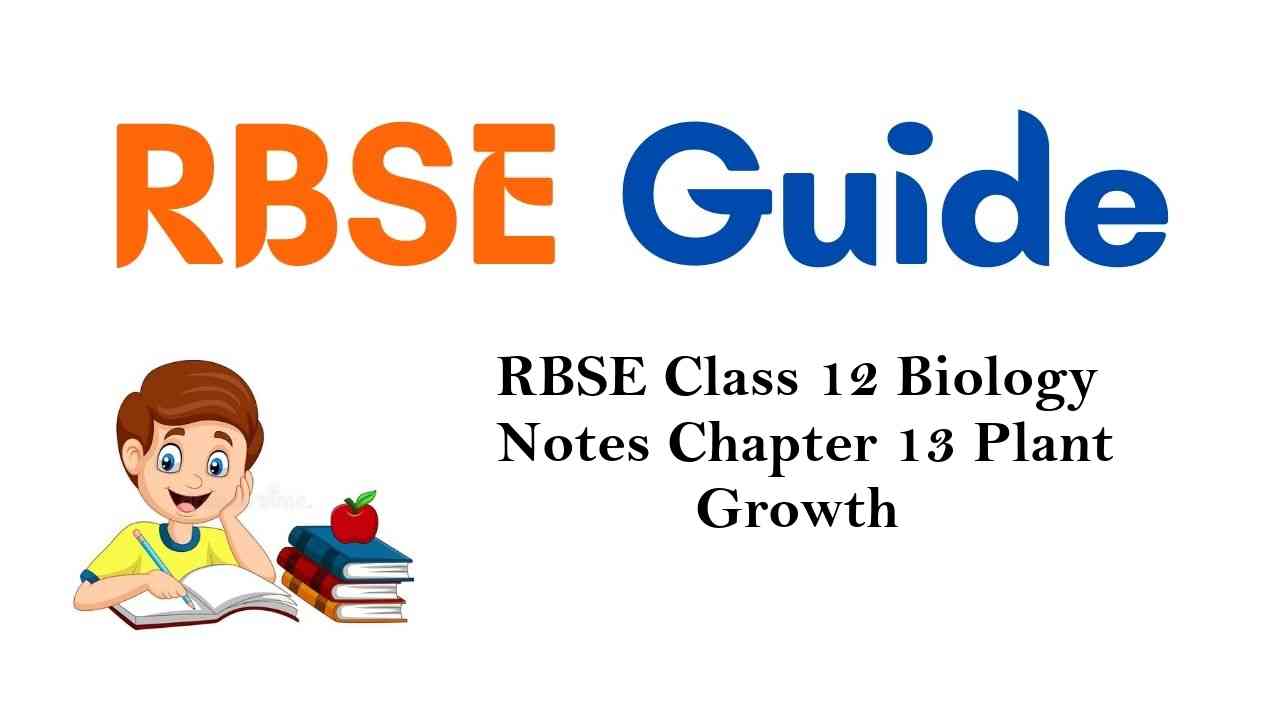Rajasthan Board RBSE Class 12 Biology Notes Chapter 13 Plant Growth
Introduction
1. Growth is a characterstic feature of all living organisms and it continues throughtout life. This is a complex process which depends on several other physiological precesses. This process brings out a permanent change in shape and size of living organisms.
2. Growth is the result of several metabolic activities which synthesize different organic compounds and form protoplasm. Besides this some other factors such as hormones are required for growth. Growth takes place when anabolic process dominate over catabolism.
Definition
1. Irreversible inerease in size accompanied with increase in dry weight and amount of protoplasm is called growth. So growth is the permanent and irreversible increase in size and shape of a cell, organ or whole organism.
2. Normalv size (volume) and dry weight both are increased during growth but it is always not necessary that incerease in size is result of growth. For example – when dry seeds are put in water, they swell up and their volume increase but their dry weight does not increases and the increase in size is not permanent because when they dry’, their size is again reduced.
Site of Plant Growth
1. In lower plants such as algae and fungi growth takes place all over the body and is not confined to some specific region.
2. In higher plants growth is restricted to some specific regions and the tissue found in these regions is called meristem.
3. The cells of meristem have the capacity to divide continue sly and add new cells in the plant body.
4. Such kind of growth where new’ cells are continuously added to the plant body by the activity of meristem is called open form of growth.
![]()
5. On the basis of the position of the meristem in the plant body, these are of three types.
(a) Apical Meristem
(b) Intercalary’ meristem
(c) Lateral Meristem
(a) Apical Meristem – The meristem found at the apices of root and shoot is called apical meristem. They form new cells by cell division which elongate and differentiate to form permanent tissue. This results into increase in length and to some extent thickness of plant. This growth is called primary growth.
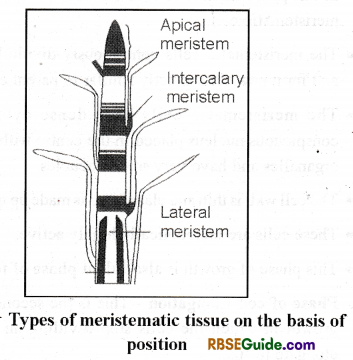
Note – In angiospenns and gymnosperms a mass of cells form apical meristem Where as in bryophytes and pteridophytes there is a single cell found at the growing point.
(b) Intercalary – Meristem- This meristem is found above the node or at the base of intemode. As a result of activity of this meristem, length of the intemode increases and hence the length of the stem increase e.g. Bambusa, Saccharum (Sugar cane), Grasses etc.
3. Lateral Meristam – This meristem is found situated along the long axis of die plant. Activity of this meristam results in to increase in girth of stem and root of gymnosperms and dircotyledons. The cells of lateral meristem divide in radial direction and form new cells towards the centre and periphery of plant body. These meristems contribute in primary growth and also in secondary growth. Example- cork combium (phellogen) and vascular cambium.
![]()
Phases of Growth
- Meristematic cells divide mitotically to form new cells
- Some of the newly formed cells continue to divided and add new cells whereas some begin to elongate and undergo differentiation to form permanent tissue and become part of mature tissue.
The whole process of growth may be divided into following three phases.
Phase of Cell Division – This is the first step of growth. In this phase number of cells increase by the division of meristematic cells.
- The meristematic cells continuously divide by mitosis and form new cells exactly similar to parent cells.
- The meristematic cells have dense cytoplasm, a conspicuous nucleus placed in the centre with other cell organalles and have very small vacuoles.
- The cell wall is thin and elastic and is made up of cellulose
- These cells are metabolically highly active.
- This phase of growth is also called phase of formation
Phase of cell Elongation – This is the second phase of growth in which the cells stop dividing and begin to elongate in size.
- The increase in size is accompained with formation of a large central vacuole.
- New cell wall material is synthesized to cope up with the enlargement.
- In this phase there is irreversible increase in size and dry weight of the cell. This phase is also called as phase of enlargement.
Phase of Differentiation – In this phase the cells differentiate and develop into specified permanent tissue.
- The cells begin to differentiate according to the function performed by these and according to their shape and size they undergoes conspicuous changes.
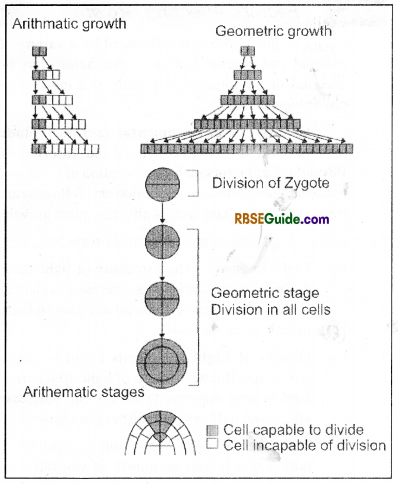
- The cell wall of the cells of mechancial tissue becomes highly thickened.
- Cell wall shows deposition of cellulose, suberin, lignin etc. and the cells mature, become strong and form permanent tissue.
- Xylem and phloem tissues are differentiated and cells undergo differentiation to form the components tissue of xylem & phloem.
- The cells show structural, physiological and biochemical differentiation by changes in their physiological and biochemical reactions.
![]()
Growth Kinetics
1. Growth rate is defined as increase in growth of an organism or a part of the organism per unit time. For example, increase in number of cells per unit time or increase in dry weight per unit time. ‘
2. Growth rate can be expressed arithmatically or geometrically.
3. Geometrically, the two daughter cells formed by one cell again divide and hence after each division the number of cells becomes double. Example- 1-2-4-8-16 and so on.
4. This geometric growth is seen in initial divisions of zygote.
5. During arithmatic growth, out of the two cells formed by each division, one differentiates into permanent tissue and one continues to divide.
6. Hence in arithmatic growth new cells are continuously added to the body resulting in the continuous growth. This can be expressed as 1-1-1-1
7. Such divisions occur in root and shoot apex.
Growth Curves
- Keeping all the factors controlling growth at optimum, the pattern of growth of the cell or organ or the whole plant is not same at all times.
- When a graph is plotted taking growth rate on one axis and time on the other, a ” S ’ shaped or sigmoid curve is obtained . This is called growth curve.
- The whole growth curve can be divided into four parts.
1. Lag Phase – This is the initial phase or period of growth In this period, the cell undergoes internal changes and stored food material is used resulting in to loss in dry weight. New cells are added due to repeated cell division and the size increases gradually.
2. Log Phase – In this phase growth rate gradually becomes rapid and the size increases exponentially with time. It means the growth rate is slow at first but it increases continuouly. It is also known as exponential phase.
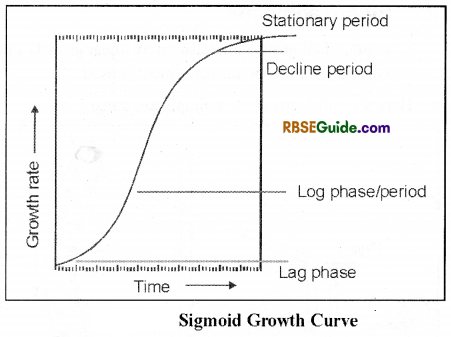
3. Decline Phase – The growth rate becomes again slow because the cells mature in this phase. The metabolic, activities also become slow.
4. Stationary or Steady phase – In this stage cells become fully mature and the rate of growth becomes almost steady. According to Sachs (1882), the time period during w hich maximum growth takes place is called grand period of growth (GPG).
Measurment of Growth
Growth in plants can be measured in term of the following.
- Increase in the number of cells produced.
- Increase in the area or volume or weight of ogran.
- Permanent increase in fresh or dry weight.
- Increase in the length and girth (in case of stem and root)
The following methods and instruments are designed to measure growth of plants.
1. Simple or Direct Method
- The most simple method to measure the growth in length of the plant or any organ of plant is, where the initial length is measured by a scale.
- After a particular interval of time the length is again measured by the scale.
- The increase in length denotes the growth in that time period.
2. By Auxanometer
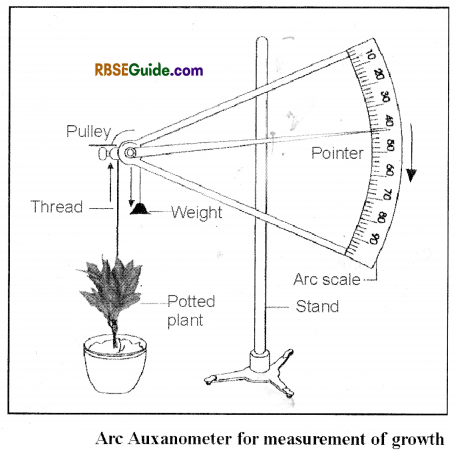
- Normally plant growth is measured by linear growth. For this purpose Auxanometer instrument is used.
- Here we will learn about a simple arc auxanometer.
- Increase in the length of the plant is measure by arc auxanometer.
- One end of a silk thread is tied to the stem tip of a potted plant.
- This thread is hung on the pully of auxanometer.
- The other end of the tinea d is kept streched by putting a suitable weight with it.
- The pulley is fixed with a long pointer which slides over a graduated arc. Initial reading of pointer is noted .
- As the stem grows in length, the weight pulls the thread down.
- This results in to the movmeent of pully and the pointer moves on the graduated arc The final reading of pointer is now noted & the growth is calculated by the following formulae.

3. Factors Affecting Growth
The plant growfh is influenced by a variety of external and internal factors. These factors may be external or enviommental factors and internal or physiological factors.
External or environmental factors include seasonal and soil related factors and Internal or Physiological factors include absorption of water and nutrients, photosynthesis, respiration etc. Following are some of the important factors affecting plant growth.
(i) Light : Light affects growth in many ways such as :
(a) Light Intensity : High intensity of light slows down the growth. It induces dwartness in plant as it reduces the size of nodes/interonodes and size of leaves become small.
(b) Quality of Light : Pigments found in plants absorb specific wavelength of light. Red part of light is most appropriate for growth; wherease ultraviolet light rays diminishes plant growth.
(c) Duration of Light : Duration of light has a remarkable impact on growth of vegetative or reproductive structures. For flowering to occur in plant, they require a fixed period of light known as photoperiod. In absence of adequate photoperiod, flowering process stops.
(ii) Water: Availability of water has direct coorelation with growth rate. The amount of water available to plants influences plant growth as w ell as its development, .All biological processes of plants, such as absorption, osmosis, transpiration, photosynthesis, respiration, germination etc. depend on water.
![]()
(iii) Temperature : Plant growth is the outcome of cellular metabolism. Since the metabolic activity of plants is directly affected by variation in temperature, the growth rate is also influenced. So it affects the growth directly or indirectly.
Generally, there is normal growth of plants between 5°C to 35°C Increase in temperature above 35°C leads to, damage to plants because of heating effect and below 0°C temperataure leads to freezing of water and inactivity of protoplasm and ultimately cells die.
(iv) Oxygen Supply: Quantity of oxygen increases growth in plants because along with growth, oxygen takes part in other biological processes, by helping in respiration process to convert potential energy into kinetic energy.
(v) Mineral Salts : Deficiency of mineral nutrients may lead to deficiency disorders or diseases and leads to decreased or stunted growth.
(vi) Plant Hormones : Growth of plants is regulated by some organic compounds which arefound in very minute quantity. These compounds are called Plant hormones or Growth hormones/regulators. Deficiency of these leads to stoppage in growth of plants.
Growth Regulatory Substances
Organic substances which are synthesized in minute quantities in one part of the plant body and transported to another part where they influence specific physiological processes and ultimately regulate the plant growth are known as growth regulatory substances or growth regulators.
Idea about growth hormone in plant was first of all presented by J. Sachs, (1882). The word hormone was first of all used by Sterling, (1902). Thimann, (1948) used the word phytohormones for plant hormones. According to Thimann,
“An organic substance produced naturally in plants controlling growth and other functions at a site far away from its place of production and active in minute amounts is known as phytohormone”. These substances basically affect and control physiological activities of plants. Growth regulators include all the naturally occurring as well as the synthetic substances which control growth.
Classification of phytohormones
Plant hormones or Growth regulators can be classified into two major groups :
(i) Growth promoting hormones: Those hormones which promote growth or growth rate are called growth promoting hormones
Example – Auxins, Gibberellin, Cytokinins and Ethylene.
(ii) Growth Inhibitory hormones: Those hormones which retard growth rate are called growth inhibitors.
Example – Abscisic acid
Growth Promoting Hormones
Such hormones which promote growth or increase the rate of growth are called growth promoting hormones. These are as follows :
Auxins
- Auxin word has orginated from a greek word “Auxien” which means “ to grow”
- Among plant hormones auxins were discovered first of all and were first isolated from human urine.
- These promote elongation of the cells of shoot or coleoptile.
- Indole acetic acid (IAA) and the other naturally eccuring or artificially sinthesized substances having properties similar to IAA are collectivley called auxins.
Discovery of Auxins
- Charles Darwin (1881) known for theory of evolution was first to realise the presence of a growth promoting substance at the apex of plant.
- Charles Darwin and Franci’s Darwin described their work, done on canary grass (Phalaris canariensis) in their book “The power of movements in plants”.
- According to Darwin, coleoptile shows bending towards source of light when it is illumionated from one side.
- On the basis of this experiment they conculded that when coleoptile is given unidirectional light, some substances are formed at the tip which are transported downwards and influence differential growth in the nonilluminated side to cause curvature towards light.
- The experiments of Darwin were carried forward by Boysen Jensen (1910-13) and Paal (1919)
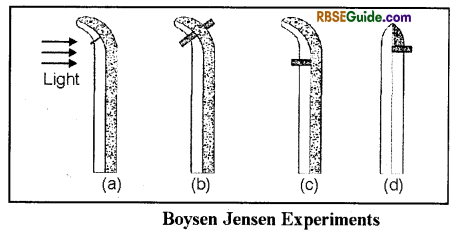
Boysen Jensen – (1910-1913) – Experimented on oat (Avena sativa coleoptile) and found that when the coleoptile is decapitated (tip of coleoptile is removed), the coleoptile does not show curvature towards light.
1. It was seen that if the decapitated tip is replaced on the cut end, the eoleoptile bends towards light.
2. It was also found that if a thin mica sheet is inserted between the decapitated tip and the stump, curvature does not take place.
3. But if in place of mica a block of gelatin is placed between stump and decapitated tip curvature resulted in usual way
4. It was further seen that if a horizontal slit is made in the non illuminated side (dark side) and a mica sheet is inserted, the coleoptile does not bend towards light.
5. But if the mica sheet is inserted in the slit towards the illuminated side, the eoleoptile shows curvature towards light.
6. From these results, Boysen Jensen concluded that some substance responsible for curvature is synthesized in the tip of coleoptile and migrates down towards the dark side (nonilluminated side.)
7. Paal (1919) also conducted similar experiments and proved that there are certain chemicals present at the apex, which promote grwoth. These chemicals are synthesized in the apex and are water soluble.
8. F.W. Went (1926-1928) is credited for discovery of auxins, as he isolated this growth regulating substance.
9. He provided final proof of the presence of some substance responsible for growth and is produced by the apex.
10. Went placed several decapitated tips of Avena coleoptile on a thin block of agar-agar (a polysaccharide which becomes gelatin like when dissolved in hot water and then cooled for sometime) and then removed the coleoplete tips after some time.
11. This agar block was then cut in to small pieces and each block was placed eccentrically on the cut end of coleoptile (stump)
12. It was observed that characteristic bending occured although the experiment was performed in darkness.
13. It was also found that by placing ordinary untreated agar block, there was no curvature.
14. This clearly established that some substance leached out (moved downwards) in the agar block from the coleoptile tip and then it migrated downward in the coleoptile where it triggered longitudinal growth on one side.
![]()
15. In his experiments Went observed that when Coleoptile is illuminated from one side, the amount of auxin is less in the illuminated side (35%) and it miarates towards the nonilluminated side (65%)
16. Displacement of hormone on nonilluminated (shaded) side of tip causes increase in amount of hormone resulting in to growth on the shaded side and hence the curvature towards the direction of light.
17. Experiments conducted by several other scientists prooved that when plumule (shoot apex) is kept in horizonal position, hormone migrates towards lower side due to gravitational force. Due to increase in concentration of auxin in the lower cells, these cells divide and the short apex bends towards upper side. This causes upward curvature of shoot apex.
18. In case of root apex, auxin retards the growth and hence dut to decreased growth on the lower side, the root tip bends downwards, causing downward curvature of radicle.
Definition of Auxins : The organic compounds capable of inducing elongation of shoot and inhibition of elongation of root at low concentration (below 10-3M or 0.001M) are known as auxins.
Chemical nature of Auxins
Auxins are of two types-
(1) Natural auxins
(2) Synthetic auxins.
1. Nature of Auxins
Kogl (1931), named Auxin to the substance which causes bending in Avena coleoptile tip.
Kog and Haagen Smit (1931) isolated the substance similar to IAAfrom the human urine and named it Auxin- A. Its chemical formula is C18H32O5.
- Kogl al further isolated another substance from human urine and named it hetero auxin. Its chemical formula is C10H9O2 and it is named as Indole- 3 acetic acid (IAA)
- IAA is the naturally occuring auxin in the plants. Other naturally accuring auxins are derivatives of IAA Two other naturally occuring auxins are 4-chloro-indole acetic acid (4 chloro IAA) and phenyl aceticacid (PAA).
- Naturally occuring auxins are formed in the apical meristem and are synthesized by tryptophan amino acid Zn is required in the synthesis of auxins.
- There is found at least some amount of auxin in every part of plant, but its amount is high in the growing parts.
- They percolate from top to base i.e. show polar movement and by diffusion pass from one cell to another.
![]()
Synthetic Auxins
- There are many chemicals which are synthesized and cause phsiological effects similar to IAA. These are called synthetic auxins.
Example
- Indole – 3 butric acid- (IBA)
- Naphthalene acetic acid- NAA
- 2, 4 dichlorophenoxy acetic acid – 2,4 D
- 2,4, 5 trichlorophenoxy acetic acid- 2, 4, 5 T
- Indole- 3 propionic acid – IPA
- Carboxy methyl thiacarbonate (CMTC)
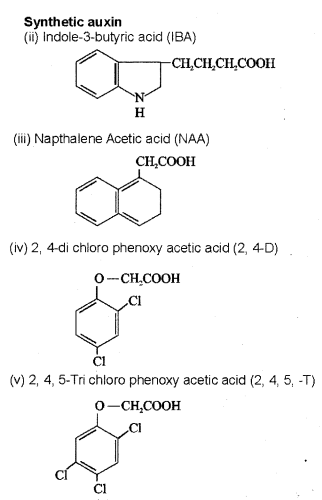
Physiological Effects of Auxins
1. Apical Dominance
- It is commonly observed that if the apical bud remains intact and growing, the lateral buds remain suppressed. This is called apical dominance.
- Removal of apical bud causes fast growth of lateral buds, and the plant becomes bush like.
- It is because of this the hedge is reguarly cut and trimmed to remove apical buds so that it becomes dense.
2. Cell Elongation
- Main function of auxin is to induce elongation of the cells which are formed by division of cells of apical meristem.
- High concentration of auxin in apical region promotes cell elongation.
- Because of this the shoot apex is negatively geotropic and positively photoropic.
3. Root Initiation
- Auxins promote initiation of adventitious roots from the nodes or basal region of stem. ,
- Plant growers use IBA and NAA to induce root formation in stem.
- Auxins promote root growth at extremely low concentration (i.e. 10-7 to 10-13M cone.)
- If the lower end of stem cutting is dipped in auxin and then planted, roots are rapidly developed. Example- Rose, Bougainvillea, Citrus, etc.
4. Parthenocarpy – The process of development of ovary in to fruit without fertilization is called parthenocary.
- Fruits formed by parthenocarpy are called parthenocarpic or seed less fruits.
- For inducing parthenocarpy, the stamens are removed in the bud stage and auxin is sprayed on the stigma.
- Seedless fruits are developed by external application of auxin in tomatoes, apples, cucumbers, orange, lemon brinzal and grapes etc.
5. Prevention of Lodging
- In many crop plants such as wheat, the thin and weak stem bends near the base due to strong winds and falls on ground. This is called lodging.
- If solution of auxin is sprayed on small young plants, the basal portion of the plants become strong and chances of falling in strong wind are reduced.
- Hence use of auxin prevents lodging.
6. Control of Dormancy
- Auxin maintains dormancy in seed and vegetative propagules (Rhizome etc.)
- Auxin prevents germination of seeds and sprouting of buds so that these can be stored for long duration.
- Potato tubers sprayed with NAA can be stored for about three (3) years.
7. Thinning of Flowers
- In some plants such as some varieties of mango, excessive flowering occurs in some years.
- As a result more fruits are formed, but they are small sized. Spray of NAA can help in preventing excessive flowering.
8. Effect on Abscission
- Premature fall of leaves, flowers and fruits is called abscission.
- This occurs due to formation of abscission layer on account of deficiency of auxin.
- Auxin prevents formation of abscission layer.
- Spray of NAA, 2,4-D, IBA etc. can help in preventing or delaying premature fall of leaves, flowers and fruits.
9 Eradication of Weeds
- Unwanted plants growing in a crop field along with crop are called weeds.
- They compete with the crop for water, minerals, light, and space etc. and do not allow proper growth of the crop.
- By use of auxin we can get rid of these weeds.
- Weeds with broad leaves can be destroyed by spraying 2, 4-D (2, 4- Dichlorophenoxy acetic acid) and grass weeds can be destroyed by use of a synthetic hormone “Delapen” (2:2- Dichloropropionic acid.)
10. Shortening of Internodes
- In some plants such as apple and pear etc. fruits are formed on short branches. In such plants by spray of NAA the intemodes of long branches are shortened and the number of short branches is increased and hence the number of fruits is increased.
- Tissue Culture
- Tissues and organs are extensively cultured artificially by tissue culture technique.
- Auxins play an important role in root formation and differentiation of callus.
- Spray of these auxins also help in increasing number of female flowers in cucurbits.
![]()
Gibberellins
1. Gibberellins were discovered in Japan and the discovery is related with a disease in Rice (Paddy) plant.
2. In 1890 a disease occured in the Rice fields in japan where some Rice plants grew extra ordinary tall and remained flowerless.
3. This disease was named as “Bakanae disease” (In Japanese language Bakanae means foolish)
4. Hori (1898) Studied this disease in detail and found that these plants were infected with a fungus (5ibberella fujikuroi (perfect state of an imperfect fungus Fusarium moniliformae).
5. The infected seedlings grew extra tall, and thin and do not bear flowers, fruits and seeds. So these were called “foolish seedling” and the disease as foolish seedling disease.
6. Kurosawa (1926) proved that secretion by the fungus sprayed on the healthy plant results in to this disease.
7. Yobuta and Hayashi (1939), isolated the substance in pure crystalline form from the culture filtrate of Gibberella fujikuroi and named it
8. Brian et. al (1954) isolated pure form of single gibberellin and named if Gibberellic acid.
9. About 100 different gibberellins have been obtained from different fungi and higher plants. These are know as GA, GA2, GA3, G4………. GA100. Among these GA3 is the first discovered and commonly found gibberellin.
Chemical Nature of Gibberellins
- All gibberellins are chemically similar .
- These are acidic in nature and chemically all gibberellins are
- A gibbene ring is found in all gibberellins.
- In some the gibbene ring has 19 carbon atom and in others it has 20 carbon atoms.
- Gibberellins show non-polar movement and are not influenced by light.
- Chemical formula of some Gibberellins are as follows
GA1– C19 H24 O6
GA2 – C19-H26 O6
GA3 – C19 H22 O6
GA4 – C19 H24 O5
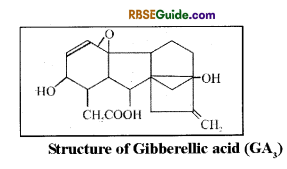
1. Internode Elongation
- Gibberellin promotes increase in length of the plant by elongation of intemode.
- It also helps in increasing the size of leaves.
- In rosette plants where a large number of leaves are attached to a very short stem axis, gibberellin elongates the axis 5-6 times the original length. This process is called Usually the rosette plants require specific photoperiod or specific cold treatment to bolt and flower.
- Genetically dwarf plants can be made to grow like tall plants by gibberellin treatment.
2. Seed Germination
- In some cereal crops such as wheat, barley, maize etc. Gibberellin plays important role in seed germination.
- Seeds of these plants absorb water and swell up and the embryo synthesizes gibberellin which diffuses in aleui on layer.
- It promotes synthesis of amylase, protease, lipase and ribonuclease enzyme.
- These enzymes break down the food stored in endosperm.
- The products formed after digestion promote growth of embryo & the seed germinates.
3. Breaking Dormancy
- Gibberellins break the dormancy of buds and seeds of some plants and promote activation of buds & germination of seeds. High concentration of gibberellins can break seed dormancy.
4. Flowering
- In some plants a specific photo period or cold treatment is needed for flowering.
- Gibberellin can replace photo period and cold treatment effect in such plants.
5. Parthenocarpy
- Formation of seedless fruits can be induced by treatment of gibberellin in many plants.
- Gibberellins are many times more effective than auxins & in many cases where auxins were ineffective, gibberellin proved effective in causing parthenocarpy. Example – Tomato, Apple, Pear etc.
Cytokinins
1. G Haberland (1913) First observed that in phloem of some plants, some substances are found which stimulate cell division.
2. Van Overbeek (1941) showed that there are certain substances in coconut milk which promote cell division.
3. Skoog and Miller (1955) isolated a very useful substance from DNA of yeast which promotes cell division and named it as kinetin.
4. Letham (1963) named Kinetin as Cytokinin.
5. Letham and Miller (1964) isolated a substance, similar to cytokinin, from endosperm, of maize and called it Zeatin.
6. Zeatin is the first naturally occuring cytokinin.
![]()
Chemical Nature of Cytokinins
1. Cytokinins are formed by breakdown of nucleic acid.
2. Structurally cytokinins are amino purines which have furfuryl ring.
3. Thus the first identified cytokinin is 6-furfuryl amino purine.
4. Cytokinins are synthesized at places where cells are continuously dividing, such as shoot apex, Root apex, developing buds, young (unripe) fruit etc.
5. Cytokinin functions as structural component of t-RNA in cytoplasm.
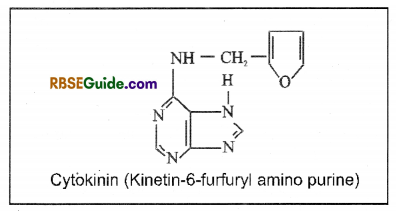
Physiological effects of Cytokinins
1. Cell Division
- The main function of cytokinins is to promote cell division in presence of auxins.
- They promote formation of meristematic tissue in plants
2. Cell Elongation
- Cytokinins promote cell elongation.
- In tobacco, cells of root when treated with cytokinin increased Runtimes in size as compared to their normal
- Cytokinins show this effect in combination with auxin and or ethylene.
3. Cell Differentiation
- Cytokinins also effect cell differentiation.
- In combination with auxins cytokinin control formation of plant organ.
- More cytokinin + less auxin → Shoot formation
- Less cytokinin + more auxin → Root formation
- Equal amount of cytokinin & auxin → Both Roots & Shoot formation.
- In tissue culture and genetic engineering, plant growth regulators are very useful as tissue culture is greatly useful in developing new varieties of plants.
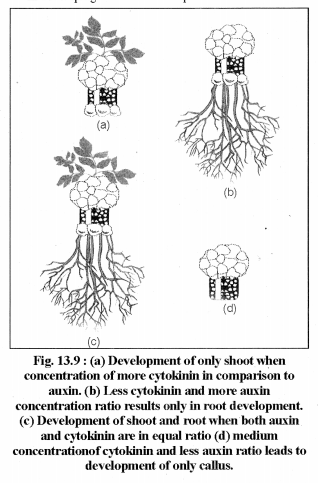
4. Counter Apical Dominance
- External application of cytokinin promotes the growth of lateral buds and reverses the effect of auxin induced dominance of apical bud.
- Cvtokinin treated plants become bushy in appearance.
5. Breaking Dormancy
- Dormaney of many seeds and vegetative propagules is broken by cytokinin and their germination is promoted.
6. Delay of Senescenee
- Cytokinin delays senescence in plants
- Normally before senescenee, proteins, chlorophyll pigment and nucleic acids etc. begin degradation and the leaves lose their chlorophyll, turn yellow and are shed from plants.
- Application of cytokinin delays the process of senescence for a few days.
- This phenomennon of delaying senescence by cytokinin is called Richmond Lang effect.
7. Etylene
- Ethylene is a volatile gaseous hormone.
- Chemically it is unsaturated hydrocarbon.
- Gane (1934) proved that ehylene is a naturally occuring gaseous hormone.
- It is synthesized by all organs of plants and promotes (stimulates) ripening of fruits.
- Normally it is found in high concentration in leaves, flowers and dormant buds.
- Its synthesis increases with fruit ripening.
- The atoms of this gaseous hormone are minute and this is soluble in water.
- In plant parts it is transported by normal diffusion.
- Ethaphone or 2-chloro ethyl phosphoric acid is used for artificial synthesis of ethylene and for fruit ripening.
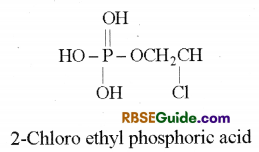
Physiological Effects of Ethylene
1. Influence on Growth
- Ethylene normally inhibits growth of root and shoot in the length and instead promotes their growth in thickness.
- Fonnation of adventatious roots increases and plants show increased radial growth.
2. Fruit Ripening
- Ethylene plays significiant role in natural ripening of fruits.
- Due to effect of ethylene, some genes become a ctive and synthesize certain enzymes which play important role in ripening of fruits.
- The fruits which produce ethylene at the time of their ripening are called climacteric fruits.
![]()
3. Effect on Flowering
- Ethylene normally has inhibitory effect on flowering in most plants but in mango and pineapple etc., ethylene promotes flowering.
- It produces feminine effect and increases number of female flowers.
4. Abscission
- Ethylene stimulates abscission in leaves, flowers and fruits
5. Senescence
- Ethylene promotes senescence in plants.
- It promotes yellowing of leaves and their senescence.
- Increase in concentration of ethylene stops metabolic activities and as a results of this leaves wilt and fall off.
Growth Inhibitors
- Those hormones or substances which inhibit rate of growth are called growth inhibitors.
- These substances are required for controlling and balancing the growth and development.
- Abscisic acid is the most important growth inhibiting hormone.
Abscisic Acid (ABA)
1. This is the most impoitant naturally occuring growth inhibitor found in plants.
2. It helps the plant to successfully survive adverse environment conditions.
3. Hence it is also called stress hormone.
4. Wareing (1963) isolated one growth inhibiting substance from the leaves of Acer plant, and named it as Dormin.
5. Addicott et.al. (1963) isolated one substance from the floral buds of cotton and named it as Abscisin.
6. Later on it was proved that dormin and abscision are same substance and these were named as Absicic Acid (ABA)
7. Chemical formula of ABA is C15H2O4
8. It is made up of 5 carbon containing three isoprene units.
9. It contains one carboxylic group (COOH)
10. ABA is synthesized by degradation of carotenoids in chloroplast on account of deficiency of water.
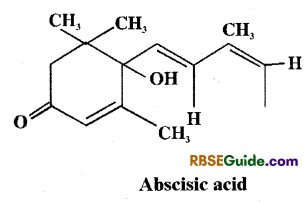
Physiological Effects of ABA
1. Abscission of Leaves
- Spray of ABA solution on leaves cause their abscission
2. Dormancy of buds and seeds
- ABA acts as growth inhibitor and promotes dormancy in seeds and buds. As a result, the growth of buds and gemination of seeds is inhibited.
3. Antitranspirant
- Small amount of ABA causes closure of stomata resulting in to decrease in rate of transpiration.
4. Inhibition of growth
- ABA inhibits cell division as well as cell differentiation thus inhibits growth.
5. Senesence
- ABA promotes senescence in leaves in many plants by causing loss of chlorophyll.
- It decreases rate of photosynthesis and alters protein metabolism and metabolism of nucleic acids.
6. Acts as stress hormone
- Synthesis of ABA increases during shortage of water in leaves and it promotes closure of stomata.
- It results in reducing the rate of transpiration up to 56 % and of photosynthesis up to 14 %
- Thus it acts as stress hormone.
Photoperiodism
1. In flowering plants, transformation from vegetative phase to reproductive phase is controlled by several factors and duration of light (Photoperiod) is one among these.
2. The role of duration of light in inducing flowering in plants is called photoperiodism.
3. In 1920, W.W. Garner and H.A. Allard of U.S. Department of Agriculture first demonstrated the role of photoperiod in the control of flowering.
4. These workers observed that the Maryland mammoth variety of tobacco (Nicotiana tabacum) sown in spring despite rich and profuse vegetative growth failed to flower during summer. When the seeds of same variety were grown in a green house during winter and the seedings were transferred to field, produced flowers and fruits in the begining of summer.
![]()
5. On the basis of the results of these experiments these scientists concluded that in these plants a critical photoperiod is necessary for flowering. In this variety of tobacco flowering is controlled by a critical factor and it was the short day length which controlls flowering.
6. They called this critical factor as photoperiod and defined photoperiodism as “Length of the day which is favourable for flowering and response of plant towards adequate day length or adequate photoperiod is called photoperiodism.”
7. According to Hillman (1969) – Developmental response of plants to the relative lengths of light and dark period is called photoperiodism.
8. It is a physiological response of plant to the length of day or night.
9. On the basis of photoperiodic response, plants are classified as follows.
(i) Short Day Plants : SDP
- Those plants which enter flowering when the day length is shorter than a certain critical photoperiod are called short day plants
- These plants need day length shorter than 12 hours and continuous long dark period (14-16 hours) for flowering.
- It is observed that if the long dark period is interrupted by even a brief flash of light, the flowering is inhibited in these plants.
- It is thus appropriate to call short day plants (SDP) as long night plants.
Examples – Nicotiana tabacum var. Maryland mammoth (Tobacco) Glycine max (Soyabean) sugar cane. Dahlia, sweet potato, mustard, Xanthium strumarium, Chenopodium rubrum, Cosmos, Chrysanthemum etc.
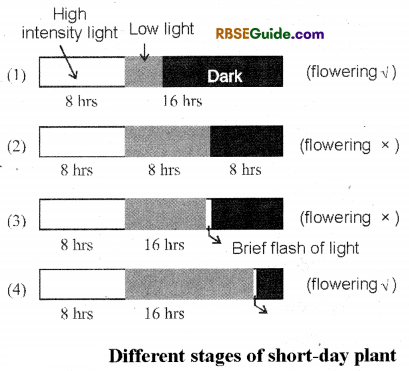
(ii) Long Day Plants (LDP)
- Those plants which enter flowering when the day length is longer than a certain critical photo period are called longday plants. (LDP)
- These plants require continuous day length longer than 12 hours and short night conditions for flowering.
- It is observed that if the long day length period is interrupted by a short period of darkness, flowering is inhibited in these plants.
- Hence it is appropriate to call long day plants (LDP) as short night plants. (SNP)
Examaples : Radish, beet root, wheat, potato, Avena sativa, (Oat), Hyoscyamus niger (Henbane), Dianthus super bus (Carnation) etc. 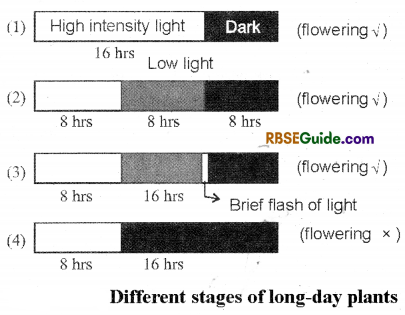
(iii) Day Neutral Plants
- Plants in which flowering is not influenced by duration of day length or dark period are called day neutral plants.
- These plants flower at a definite time irrespective of photoperiodic conditions.
- The day neutral plants are also called photoneutral plants
Examples – Tomato, Cotton, Capsicum, Sunflower, Maize etc.
Site of Potoperiodic Stimulus
- Light stimulus is mainly perceived by leaves (leaf) and buds. Chailakhyan (1936), concluded from his experiments that a single leaf of a plant is sufficient to get light stimulus. Well developed leaves are more capable to perceive light stimulus as compared to newly formed leaves.
- Fully mature or old leaves show decreased perception for light stimulus gradually.
- Photoperiodic stimulus can be transmitted from leaves to floral buds through phloem but is independent of transport of photosynthetic products.
Mechanism of Photoperiodism
Several theories have been proposed to explain mechanism of photoperiodism. Some of the important theories are as follows :
1 Florigen Hypothesis
- It is also called Chailakhyan hypothesis
- According to this hypothesis a flowering honnone namely florigen is synthesized in the leaves under favourable photoperiodic conditions.
Florigen is a mixture of two compounds.
- Gibbereilins – These are necessary for growth and differentiation of stem.
- Antliesins – These are necessary for inducing flowering.
Note – Higher amount of gibbereilins is necessary for flowering in longday plants (LDP) whereas higher amount of anthesins is required for flowering in short day plants (SDP). ‘
- In LDP growing under short day condition, there is sufficient amount of anthesin but gibberellin is insufficient. Hence an increase in amount of gibberellin is necessary for inducing flowering either by external application on leaves or by endogenous synthesis of gibbereilins by leaves. In SDP the situation is reversed.
- In short day plants growing under long day conditions gibberellin is in high amount but anthesin is insufficient. When these plants are shifted to short day conditions, amount of anthesin increases and the flowering is induced.
- Unfortunately florigen or substance like anthesin has not been isolated by now. Therefore this hypothesis was not accepted.
Phytochrome Theory
- This concept was postulated by Borthwick and Hendricks (1950) ‘
- According to this theory a photoreceptive pigment is found in the leaves of plants, which is called phytochrome.
- Phytochrome is a bright blue or bluish green protein containing substance which is found in two interconvertible forms.
- These two forms are :
(a) Phytochrome far-red (Pfr-P730)
(b) Phytochrome red (Pr – Pg60) - Pfr absorbs light of far red region (730 mm) where as Pr absorbs light of red region (660mm)
- (P660) when absorbs red light, it changes in to Pfr (P730) and when Pfr (P730) is exposed to far red light it quickly changes back to Pr. (P660) form This change also occurs slowly in darkness.
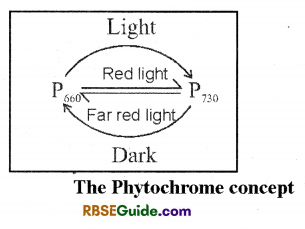
Note : During presence of sunlight (day time), phytochrome Pfr accumulates in sufficient amount and this inhibits flowering in shortday plants (SDP) and promotes flowering in longday plants. (LDP)
In the absence of light (during darkness) phytochrome Pfr changes to phytochrome Pr form,and hence amount of Pr accumulates. It promotes flowering in short day plants (SDP) and inhibits in long day plants (LDP)
It is believed that these two forms of phytochrome control the formation of hormone which induces flowering.
![]()
Dormancy
- When seeds are fully developed their further growth stops.
- In some plants, the fully developed seeds germinate immediately after their formation, if favorable conditions are available.
- But in some other plants the fully formed seeds do not germinate even when all conditions for germination are favourable.
- This indicates that these seeds are functionally inactive.
- This state of seeds is called dormant state and the condition is called dormancy.
- In dormant seeds germination is temporarily suspended for some time and these seeds remain viable for long duration.
The dormancy period of seeds of some plants is given in the following table.
| Name of Plant | Suspended Period/ Dormancy | |
| 1 | Rhizophora, Pea, Pulses | Absent |
| 2 | Most crop Plant | 2-5 years |
| 3 | Desert Plants (Acacia, Grasses) | 5-10 years |
| 4 | Lupin (In arctic region Tundra) | 100 years |
Primary and Secondary Dormancy
- Primary dormancy—When the seeds fail to germinate immediately after their maturation even under favourable conditions due to their structural or physiological reasons, the dormancy is called primary dormancy.
- Secondary dormancy—In seeds of some plants, after their maturation some changes occur during their storage and the seeds become dormant. This is called secondary dormancy.
Factors affecting dormancy
Seed-dormancy is due to many external or internal factors as described below :
(1) Hard seed coat: In some seeds, seed coat is very hard. It is impermeable to water (Gram, Pea) and oxygen (Xanthium) required at the time of germination. Sometimes it act as mechanical barrier and resists development of embryo. Example
(2) Immaturity of embryo : In some plants seeds are dispersed (dehiscence) even before maturity of the embryo. So germination of seed will not occur until unless the embryo fully matures. Example: Ginkgo biloba, Gnetum gnemone.
(3) Requirement of “after ripening period”: Seeds of some plants do not germinate immediately after formation. But germinate after completing a certain resting phase. During resting stage they acquire capacity of germination. This resting period is “after ripening period”. It varies from weeks to months in different plants e.g.-wheat, Sorghum,
(4) Requirement of specific temperature and light:
seeds of some plants require a cold treatment before germination. Until unless these seeds pass through specific cold temperature treatment, they do not germinate. In winter season, these seeds germinate naturally. Optimum temperature for cold treatment is 0°C to 5°C.
Example – Cherry, Oak. In the similar way germination of some seeds depend on photoperiod, quality and quantity of light. These seeds are sensitive to light factors and are called Photoblastic. Example : Tobacco, Capsella etc.
5. Presence of germination inhibitors : There are certain substances present in fleshy fruits, which inhibit germination. It includes abscisic acid (ABA), coumarin, para-ascorbic acid, phenolic acid etc. When these seeds remain in soil, these substances are gradually passed away (filtered out) and then germination can occur. The inhibitory effect of these substances can be neutralised by application of gibberellin.
Methods of breaking seed dormancy
Various methods are applied ibr breaking seed dormancy. These depend on dormancy factor and plant species. Some of the methods to break seed- dormancy are given below:
1. Scarification : Hard seed coat is weakend either by breaking or scratching so that the seeds can absorb water easily. Seeds are also made soft either by soaking them in dilute sulphuric acid (H2S04), hot water or fat solvents.
2. Chilling Treatment : Those seeds which require chilling treatment for breaking dormancy are exposed to artificial chilling treatment to break their dormacny.
3. Exposure to alternate temperature : Seed dormancy in some can be broken by subjecting them to alternate high and low temperature exposure.
4. Light : Exposure of positive photoblastic seeds with red light can increase the efficiency of seed germination.
5. Pressure : Some seeds if kept on 2000 atmospheric pressure at 18°C to 20°C show increase seed germination capacity because of softening of seed coat and increase in permeability.
6. Use of growth regulators : Dormancy due to chilling treatment, after ripening period, presence of germination inhibitors, requirement of specific light, can be broken by use of growth regulators. Example : Gibberellin, Ethylene, Chlorohydrin and Thiourea.
Vernalization
- In majority of plants, besides photoperiod temperature also has important role in growth and development.
- Response of plants towards temperature relating to growth and development was first observed by a Russian scientist Lysenko (1928) while working on winter and spring varieties of rice.
- In annual plants light has the major effect on flowering and effect of temperature is secondary.
- In biennial plants the situation is different. In these plants there is only vegetative growth in first year and flowering is completed in second year.
- Before flowering cold temperature exposure of winter is necessary in these plants, and in absence of cold treatment reproductive stage does not begin and they remain in vegetative stage.
- The method of inducing flowering by chilling (cold) treatment is called
- According to Choird (1960) vernalization can be defined as “ Inducing ability of flowering by chilling treatment artificially is called vernalization.”
Technique and mechanism of vernalization
- The seeds are soaked in water and are allowed to germinate.
- These germinated seeds are treated at low temperature (0° to 5°C)
- The time of exposure depends on type of species and variety and varies from a few hours to a few weeks.
- During cold treatment, certain hormone like substances are formed which control vernalization.
- Melchers (1939) named this substance as
- According to Lanng (1952), vernalin is a precursor of hormone florigen which induces flowering.

Note – Vernalin and florigen are both hypothetical hormones and these have not been isolated till date. The embryo and the meristematic tissue are the receptive site of cold treatment effect.
If vernalized seeds or plants are exposed to high temperature, then the effect of vernalization is lost. This is called devernalization.
Senescence
No organism is immortal and every organism borne on earth, after completing some time (it’s life span), dies. The duration between the birth and natural death of an organism is called it’s life span.
1. When an organism attains maturity during its life span, such deteriorative process begins which leads to the death of the organism.
- Hence the period between maturity of any organism and its death is called senescence.
- During senescence the organism becomes weak, and its functional capacity decreases.
- Metabolic substances are stored and the dry weight decreases.
![]()
A.C. Leopold (1961) has described four types of senescence. ‘
1. Whole plant senescence – In most annual plants, after fruit formation, the whole plant becomes yellowish and finally dies. This is called whole plant senescence. Example – Wheat, Grain, Mustard, Tomato etc.
2. Top or shoot senescence – In this type of senescence, the above ground part dies every year after the end of growing season and the underground stem and roots remain living. In next growing season buds develop in the under ground stem and aerial parts are again formed. Example – Potato, Ginger, Onion etc.
3. Leaf Senescence – In most perennial trees, leaves die in autumn and fall off. The stem and roots survive and remain alive. On return of favourable conditions new leaves are again formed.
4. Gradual senescence – In majority of annual plants during normal life span, the old leaves die first and fall off. Gradually other leaves, stem and root also undergo senescence and die. In this type of senescence the whole plant disappear gradually. This is called sequential senescences.
- ABA mainly promotes senescence in leaves and ethylene promotes senescence in fruits.
- Auxins, gibberellins and cytokinin, in most cases counter or delay the process of senescence.
Abscission
1. Shedding of leaves, flowers and fruits from the mother plant by a natural process is called abscission.
2. It is a biological process which is initiated due to changes in the cells of basal portion of the parts which fall off.
3. The middle lamella and the cell wall of the cells in the basal portion are digested by pectinase and cellulase enzymes.
4. As a result of breaking of middle lamella and cellwall, cells in a definite region begin to separate from each other. The tissues in this area become weak and soft and a layer is formed which is called as abscission layer.
5. The cells situated just below the abscission layer become meristematic and form cork cells. This cork forms a protective layer or abscission zone.
6. Due to strong wind or rain the plant part separates from the region of abscission and fall off.
7. Abscission is due to change in the hormonal balance. Abscisic acid plays major role in the process of abscission
RBSE Class 12 Biology Notes
